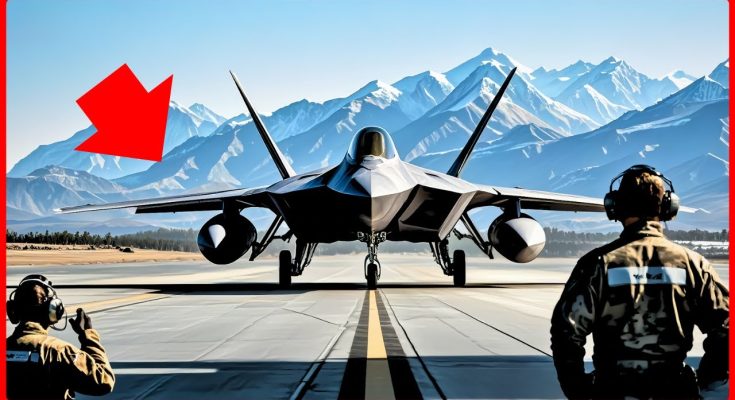REVEALED: USAF’s CONTROVERSIAL Decision to Keep F-22 Raptor Flying Until 2060!
In a surprising and controversial move, the United States Air Force (USAF) has decided to extend the operational life of its F-22 Raptor fighter jet until 2060. This decision, which has raised eyebrows among defense analysts and military strategists alike, ensures that one of the most advanced and lethal air superiority fighters in history will remain a cornerstone of the U.S. military’s air combat strategy for decades to come. But what prompted the USAF to make this bold decision, and what implications does it have for future fighter jet development?
The F-22 Raptor: An Icon of Air Superiority
The F-22 Raptor, developed by Lockheed Martin and entering service in 2005, is widely regarded as one of the most advanced fighter jets ever built. Known for its exceptional stealth, agility, and supercruise capability (the ability to fly at supersonic speeds without afterburners), the F-22 is designed to maintain air dominance in the most contested environments. Its advanced radar and sensor systems, combined with its incredible maneuverability, make it nearly unmatched in aerial combat.
However, despite its remarkable capabilities, the F-22 was produced in limited numbers, with only 187 units built due to the program’s high costs. Following its introduction, the aircraft’s production was halted in 2009, leaving the fleet smaller than initially anticipated. The F-22’s future was uncertain for years, especially as newer platforms like the F-35 Lightning II and the Next Generation Air Dominance (NGAD) program began to take center stage.
The 2060 Decision: A Strategic Necessity?
The USAF’s decision to keep the F-22 flying until 2060 is both a practical and strategic one. A central factor driving this decision is the aircraft’s continued superiority in air-to-air combat. Although the F-35 has become the cornerstone of the U.S. fighter fleet due to its multirole capabilities and stealth features, the F-22 remains unmatched in its primary mission: air superiority. The jet’s combination of advanced radar evasion, high-speed maneuvering, and unmatched combat agility makes it a formidable opponent, even against more modern or future adversaries.
With China and Russia rapidly modernizing their air forces and fielding advanced fighter jets like the Su-57 and the J-20, the F-22 provides the U.S. with an essential edge in maintaining air dominance. Extending the life of the F-22 ensures that the USAF retains an unparalleled advantage in air-to-air combat for the foreseeable future, buying valuable time as the U.S. develops and fields new technologies.
The Controversy: Cost vs. Capability
While the decision to keep the F-22 in service until 2060 may appear logical on the surface, it has sparked significant controversy within military circles. The primary criticism revolves around the high cost of maintaining an aging fleet of advanced aircraft. The F-22’s advanced technologies and complex systems make it expensive to maintain and upgrade. The aircraft’s parts and components are becoming harder to source, and many systems are becoming outdated as newer technologies emerge.
Critics argue that the USAF’s investment in the F-22 could divert valuable resources away from the development of next-generation fighters, including the NGAD program, which is being developed as a potential successor to the F-22 and F-35. By keeping the F-22 flying until 2060, some fear that the U.S. may be delaying the full-scale production of the next-generation fighters that will ultimately define future air combat.
Furthermore, the decision has been questioned in light of the F-35’s growing capabilities. The F-35 is designed to be a multirole fighter, able to perform a wide variety of missions beyond air superiority, including ground attack, intelligence gathering, and close air support. As the F-35’s operational effectiveness increases with continual upgrades, some believe the F-22’s air superiority role could eventually be fulfilled by a more versatile and cost-effective fleet of F-35s.
The F-22’s Future Role: Supplementing, Not Replacing
Despite the controversy, the USAF is clear about its intentions. The F-22 will not be the sole pillar of U.S. air combat in the coming decades. Instead, it will be integrated into a broader, multi-layered strategy of air superiority that includes the F-35, advanced drones, and future 6th-generation platforms like the NGAD. The F-22 will complement these newer technologies, ensuring the U.S. maintains a robust and flexible air combat capability.
The extended lifespan of the F-22 also opens the door for future upgrades, including improvements to avionics, weapons systems, and software, to ensure the fighter remains relevant against evolving threats. This includes possible enhancements to its stealth capabilities, radar systems, and integration with the increasing use of unmanned systems and artificial intelligence in military operations.
Conclusion: The Strategic Gamble
The USAF’s decision to keep the F-22 Raptor flying until 2060 represents a calculated risk. While the fighter’s unmatched air superiority and stealth capabilities remain essential, the high cost of maintaining an aging fleet raises questions about the long-term sustainability of this strategy. By extending the F-22’s service life, the USAF buys time for the development of new technologies while retaining a formidable advantage in air-to-air combat.
Ultimately, this decision is a balancing act between preserving the capability of an iconic fighter while preparing for the future. Whether or not the USAF’s gamble will pay off depends on how effectively the F-22 can be upgraded, how well future technologies like NGAD are integrated, and whether the cost of maintaining the fleet is sustainable in the long run. For now, the F-22 will remain a vital part of America’s air superiority strategy for decades to come.



